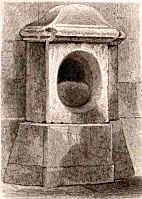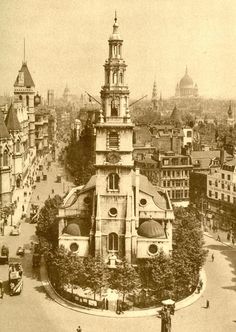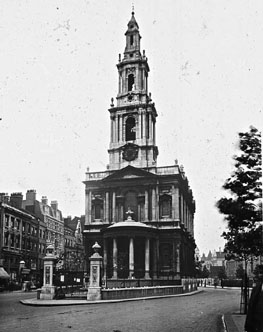This is perhaps one of London’s best-kept secrets, a prehistoric standing stone right in the heart of the city. It is correctly known as London Stone not the London Stone, as it has been venerated for so long. There are some who say that it is medieval but the Elizabethan historian John Stow thought it so old that no-one knew who had put it there and what it was for (see below). It has been suggested that it was a Roman mile-stone, this is however is unlikely as a Roman stone would certainly have had inscriptions and be similar in form to other Roman mile-stones.

London Stone in the 19th
century. Note that the surrounding stonework 1820s still exists largely unaltered
in its present form (see
link below for modern appearance)
Also, if Roman, it would most likely have been set up in the Forum (see link below) and yet it is nowhere near the Roman Forum.
Most legends say that Prince Brutus the (legendary) founder of London had it put there, circa 1,100BC, in which case it is probably exotic in origin, possibly even from Troy, and it ought to be possible for geologists to work out its origins by analysing a sample of the stone. The good news is that the stone is going to the Museum of London and will be on show while the present building is being redeveloped, I can't help thinking it shouldn't be moved but they are at last, going try to find the original source of the stone. If it was put there by Prince Brutus then it might come from north west Turkey the location of Troy but these kind of stones that are carried from place to place like the Stone of Destiny - the Stone of Scone, are presumably, in part, mementos reminding peoples from where they had come from. The Trojans claimed they came from Crete, there is a Mount Ida in Crete and another at Troy, both sacred, so this seems possible, so perhaps the stone could have been brought with them form Crete. There are some people who think that the Trojans, much earlier back in time, migrated from Britain, if this is true and the stone dates back to this time then it might be a local stone, even though it would have traveled far and wide, and it would alas prove nothing one way or another.
It now stands on the side of a sports shop (but for not much longer) in Cannon Street, near Cannon Street Station, which before the blitz was Saint Swithin's church, which was damaged very badly and was demolished in the 1960s. It sits in a small alcove and has been described as being the size of a television but was originally much bigger.
Some say it is earlier than this and it was originally a prehistoric standing stone (of course it would still be prehistoric if placed there by Brutus - Late Bronze Age). There is no reason why this should not be the case as standing stones are relatively common in Britain. However, it is known that it was fixed to the ground with iron bars, but this might be a later repair. It is worth noting that as Prince Brutus was a Trojan he would have been familiar with iron, as iron weapons seem to have been used in the Trojan Wars as Homer mentioned iron in the Iliad in a way that suggests they knew about it.
This is what E.O. Gordon in 'Prehistoric London its Mounds and Circles' has to say about the stone
Stow [an Elizabethan historian] describes London Stone as ''standing in Walbrook, on the south side of this High Street, neere unto the Channell, is pitched upright a great stone called London Stone, fixed in the ground very deep, fastened with bars of iron, and otherwise so stronlglie set that if cartes do runne against it through negligence the wheeles be broken, and the stone itself unshaken. The cause why this stone was there set, the verie time when, or other mermorie thereof, is there none." London Stone is mentioned as early as the time of Athelstane, King of the West Saxons, without any positive reference to its having been considered a Roman Military stone. We hear of London Stone in the time of Richard II when Jack Cade struck his sword on it. The act was meant to give solemn assurance to the people of his rude fidelity.
However it is also possible that it was the index stone (a stone that lies outside the circle) of a stone circle that originally stood where Saint Paul’s is now. This, at least, is the theory that E.O. Gordon develops in her book, she used comparative archeology, where she studied all the ancient monuments for similarities and came to the conclusion, based on other ancient cities, that cathedrals were invariably built on the sites of ancient stone circles. This of course is a supposition, although one that might be verified one day by archeologists, she certainly has a good track record. In 1914 she predicted that there was Roman masonry in the Tower of London complex and this has recently been confirmed, she also correctly predicted that most British ancient monuments were surrounded by a ditch which is also correct. The name London Stone may be a further clue to its age for had it been put there by Brutus it would most likely have been called the Brutus Stone or some such name.
Although London Stone has been in the present position for sometime it has not always been in that place. It once stood in the centre of Cannon Street . What is certain is that it is on an ancient ceremonial route, the Coronation Procession.
This started at the Tower of London and went along Cannon Street, through the Medieval St Paul's (the cathedral's nave was used by pedestrians as a short cut), and along the Strand and Whitehall to Westminster Abbey - and it is sill used to this day It is interesting to note how many monuments and churches are in the middle of this route, particularly striking are the churches in the middle of the road in the Strand., St Clements Dane, and St Mary-le-Strand, but also St Paul's which on old maps is effectively in the middle of the road. There is another church in the middle of the road and that is St Mary's Church, Bow in Bow Road, Bow. This seems to be a road that is different from the ceremonial route, it is the road that led out of the City of London at Aldgate the 'olld gate' but it is likely to be the same sort of date becuse of this unusual fearure.


This is a useful link
http://www.bbc.co.uk/dna/h2g2/A863309
home
| missing Roman road | The
real Troy discovered | pre-Roman London
| Britain's forbidden history | contact
the author

